AIPT SPOA3: Specific Populations and Older Adults Case Study 1
VerifiedAdded on 2022/11/25
|12
|3481
|355
Case Study
AI Summary
This case study assesses a fitness instructor's ability to understand and apply pre-exercise screening tools for ten clients from specific populations, including older adults. The assessment requires the student to analyze each client's screening results, identify risk factors, and determine the need for referral to allied health professionals. The student must select appropriate health and fitness appraisals, identify barriers to exercise, and develop safe and effective exercise programs, including training methods, precautions, and equipment recommendations. The case study also emphasizes the importance of regular progress reviews and the ability to modify exercise plans based on individual client needs and medical clearance. The scenarios cover a variety of health conditions and considerations, ensuring a comprehensive evaluation of the student's knowledge and practical skills in exercise prescription and client management.
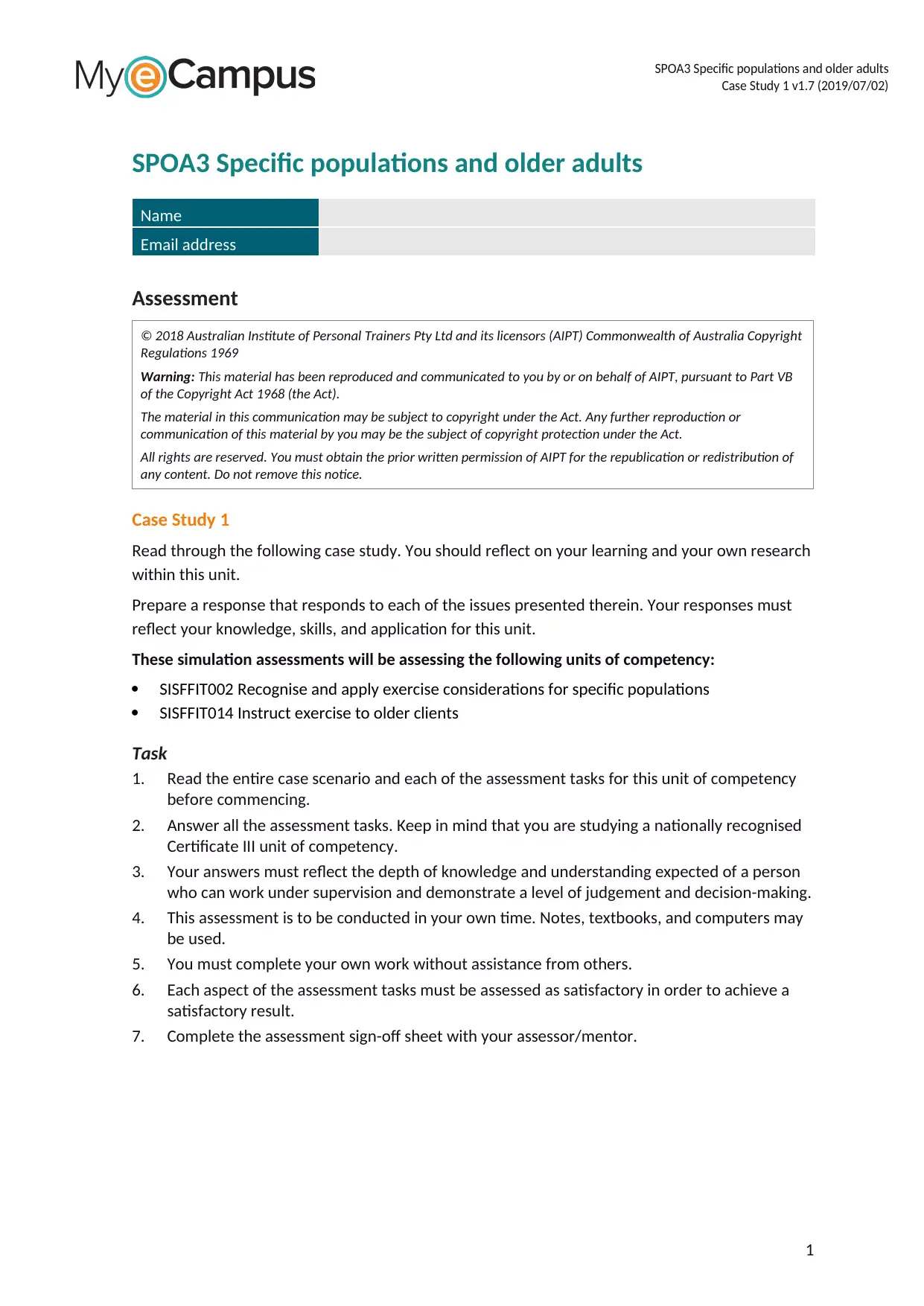
SPOA3 Specific populations and older adults
Case Study 1 v1.7 (2019/07/02)
SPOA3 Specific populations and older adults
Name
Email address
Assessment
© 2018 Australian Institute of Personal Trainers Pty Ltd and its licensors (AIPT) Commonwealth of Australia Copyright
Regulations 1969
Warning: This material has been reproduced and communicated to you by or on behalf of AIPT, pursuant to Part VB
of the Copyright Act 1968 (the Act).
The material in this communication may be subject to copyright under the Act. Any further reproduction or
communication of this material by you may be the subject of copyright protection under the Act.
All rights are reserved. You must obtain the prior written permission of AIPT for the republication or redistribution of
any content. Do not remove this notice.
Case Study 1
Read through the following case study. You should reflect on your learning and your own research
within this unit.
Prepare a response that responds to each of the issues presented therein. Your responses must
reflect your knowledge, skills, and application for this unit.
These simulation assessments will be assessing the following units of competency:
SISFFIT002 Recognise and apply exercise considerations for specific populations
SISFFIT014 Instruct exercise to older clients
Task
1. Read the entire case scenario and each of the assessment tasks for this unit of competency
before commencing.
2. Answer all the assessment tasks. Keep in mind that you are studying a nationally recognised
Certificate III unit of competency.
3. Your answers must reflect the depth of knowledge and understanding expected of a person
who can work under supervision and demonstrate a level of judgement and decision-making.
4. This assessment is to be conducted in your own time. Notes, textbooks, and computers may
be used.
5. You must complete your own work without assistance from others.
6. Each aspect of the assessment tasks must be assessed as satisfactory in order to achieve a
satisfactory result.
7. Complete the assessment sign-off sheet with your assessor/mentor.
1
Case Study 1 v1.7 (2019/07/02)
SPOA3 Specific populations and older adults
Name
Email address
Assessment
© 2018 Australian Institute of Personal Trainers Pty Ltd and its licensors (AIPT) Commonwealth of Australia Copyright
Regulations 1969
Warning: This material has been reproduced and communicated to you by or on behalf of AIPT, pursuant to Part VB
of the Copyright Act 1968 (the Act).
The material in this communication may be subject to copyright under the Act. Any further reproduction or
communication of this material by you may be the subject of copyright protection under the Act.
All rights are reserved. You must obtain the prior written permission of AIPT for the republication or redistribution of
any content. Do not remove this notice.
Case Study 1
Read through the following case study. You should reflect on your learning and your own research
within this unit.
Prepare a response that responds to each of the issues presented therein. Your responses must
reflect your knowledge, skills, and application for this unit.
These simulation assessments will be assessing the following units of competency:
SISFFIT002 Recognise and apply exercise considerations for specific populations
SISFFIT014 Instruct exercise to older clients
Task
1. Read the entire case scenario and each of the assessment tasks for this unit of competency
before commencing.
2. Answer all the assessment tasks. Keep in mind that you are studying a nationally recognised
Certificate III unit of competency.
3. Your answers must reflect the depth of knowledge and understanding expected of a person
who can work under supervision and demonstrate a level of judgement and decision-making.
4. This assessment is to be conducted in your own time. Notes, textbooks, and computers may
be used.
5. You must complete your own work without assistance from others.
6. Each aspect of the assessment tasks must be assessed as satisfactory in order to achieve a
satisfactory result.
7. Complete the assessment sign-off sheet with your assessor/mentor.
1
Paraphrase This Document
Need a fresh take? Get an instant paraphrase of this document with our AI Paraphraser

SPOA3 Specific populations and older adults
Case Study 1 v1.7 (2019/07/02)
In order to complete this assessment, you will need to access the ten (10) pre-exercise screening
tools for the following clients:
Mario Mendes
Alison Nosila
John Ode
Kate Keats
Anastasios Raptis
Kelly Brown
Kinu Honda
Pedro Sagan
Ann Marie
Janet Tena
The role of a fitness instructor requires understanding and identifying a client’s contraindications
to exercise and assessing whether the client requires a referral to a more qualified allied health
professional.
In this task, the student will be required to use industry-endorsed pre-exercise screening tools and
risk stratification processes to identify the risk level of the following ten (10) special population
clients. In doing so, the student will need to ensure that the following criteria are met:
Review and advise client of outcomes of pre-exercise health screening procedures.
Develop and document program plans that incorporate instructional information and
guidance from medical or allied health professionals if required.
Discuss and confirm the client’s understanding of potential signs and symptoms of intolerance
contraindications to exercise and of recommended precautions.
Refer client to medical or allied health professionals as required.
Determine the type of training, training methods, and equipment required to achieve the
client’s goals.
Client 1: Mario Mendes
Review Mario’s pre-exercise screening tool, and answer the following questions.
1. According to the risk stratification from stage 2, how many risk factors does Mario have?
The subject has two risk factors
2. Taking into consideration the results of stages 1 and stage 2, does the client require a
referral?
The client might need a referral
3. If so, identify which AHP is the most appropriate for referral.
An exercise physiologist is the most appropriate for referral
4. From the list below, identify at least ONE health and fitness appraisals that is appropriate for
Mario prior to referral.
• Blood pressure
• Girth measurements
• BMI
• Hip-to-waist ratio
• Queen’s College step test
• Shoulder flexibility test
• Wall sit test
• Push-up test
Queen’s College step test
2
Case Study 1 v1.7 (2019/07/02)
In order to complete this assessment, you will need to access the ten (10) pre-exercise screening
tools for the following clients:
Mario Mendes
Alison Nosila
John Ode
Kate Keats
Anastasios Raptis
Kelly Brown
Kinu Honda
Pedro Sagan
Ann Marie
Janet Tena
The role of a fitness instructor requires understanding and identifying a client’s contraindications
to exercise and assessing whether the client requires a referral to a more qualified allied health
professional.
In this task, the student will be required to use industry-endorsed pre-exercise screening tools and
risk stratification processes to identify the risk level of the following ten (10) special population
clients. In doing so, the student will need to ensure that the following criteria are met:
Review and advise client of outcomes of pre-exercise health screening procedures.
Develop and document program plans that incorporate instructional information and
guidance from medical or allied health professionals if required.
Discuss and confirm the client’s understanding of potential signs and symptoms of intolerance
contraindications to exercise and of recommended precautions.
Refer client to medical or allied health professionals as required.
Determine the type of training, training methods, and equipment required to achieve the
client’s goals.
Client 1: Mario Mendes
Review Mario’s pre-exercise screening tool, and answer the following questions.
1. According to the risk stratification from stage 2, how many risk factors does Mario have?
The subject has two risk factors
2. Taking into consideration the results of stages 1 and stage 2, does the client require a
referral?
The client might need a referral
3. If so, identify which AHP is the most appropriate for referral.
An exercise physiologist is the most appropriate for referral
4. From the list below, identify at least ONE health and fitness appraisals that is appropriate for
Mario prior to referral.
• Blood pressure
• Girth measurements
• BMI
• Hip-to-waist ratio
• Queen’s College step test
• Shoulder flexibility test
• Wall sit test
• Push-up test
Queen’s College step test
2
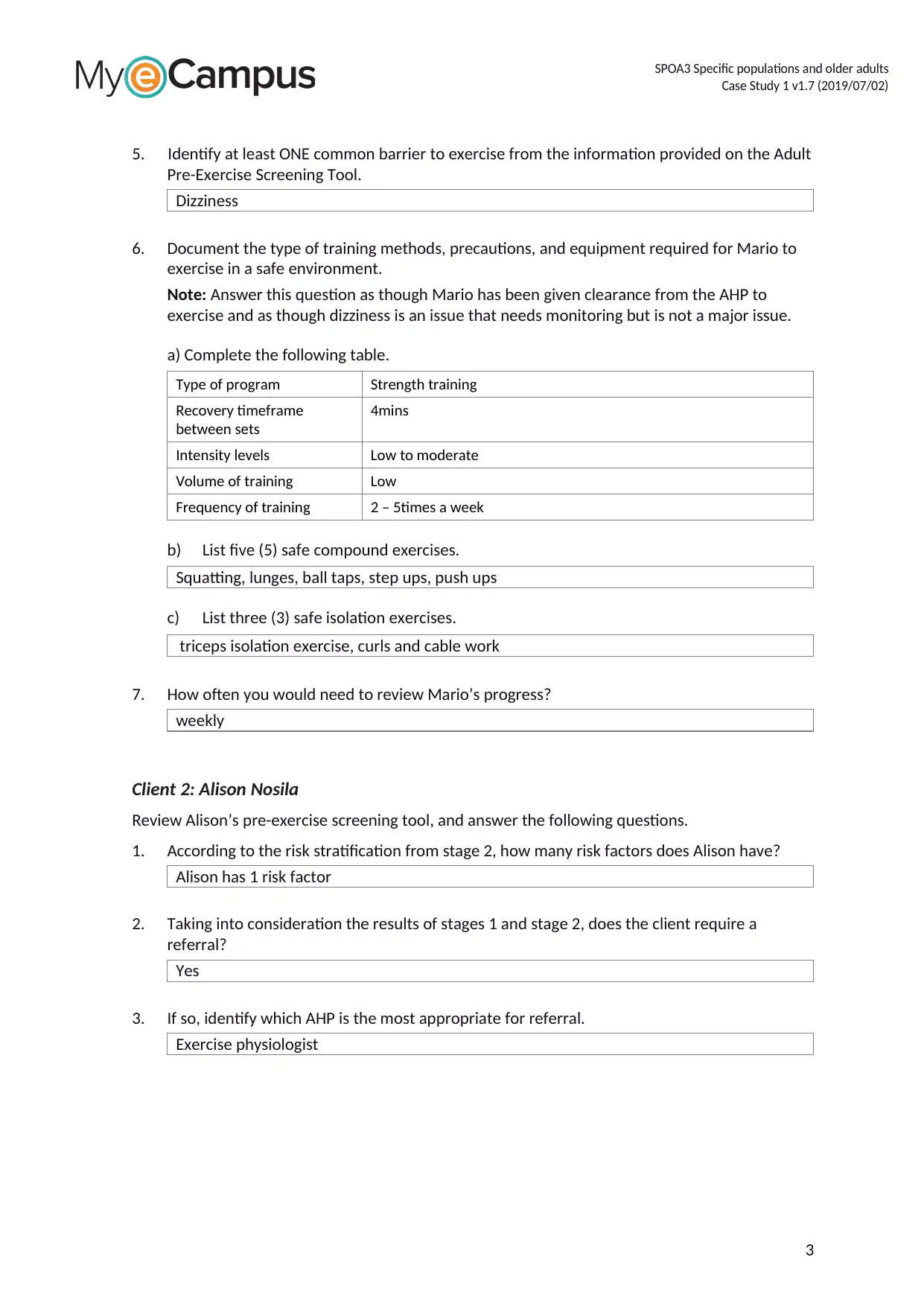
SPOA3 Specific populations and older adults
Case Study 1 v1.7 (2019/07/02)
5. Identify at least ONE common barrier to exercise from the information provided on the Adult
Pre-Exercise Screening Tool.
Dizziness
6. Document the type of training methods, precautions, and equipment required for Mario to
exercise in a safe environment.
Note: Answer this question as though Mario has been given clearance from the AHP to
exercise and as though dizziness is an issue that needs monitoring but is not a major issue.
a) Complete the following table.
Type of program Strength training
Recovery timeframe
between sets
4mins
Intensity levels Low to moderate
Volume of training Low
Frequency of training 2 – 5times a week
b) List five (5) safe compound exercises.
Squatting, lunges, ball taps, step ups, push ups
c) List three (3) safe isolation exercises.
triceps isolation exercise, curls and cable work
7. How often you would need to review Mario’s progress?
weekly
Client 2: Alison Nosila
Review Alison’s pre-exercise screening tool, and answer the following questions.
1. According to the risk stratification from stage 2, how many risk factors does Alison have?
Alison has 1 risk factor
2. Taking into consideration the results of stages 1 and stage 2, does the client require a
referral?
Yes
3. If so, identify which AHP is the most appropriate for referral.
Exercise physiologist
3
Case Study 1 v1.7 (2019/07/02)
5. Identify at least ONE common barrier to exercise from the information provided on the Adult
Pre-Exercise Screening Tool.
Dizziness
6. Document the type of training methods, precautions, and equipment required for Mario to
exercise in a safe environment.
Note: Answer this question as though Mario has been given clearance from the AHP to
exercise and as though dizziness is an issue that needs monitoring but is not a major issue.
a) Complete the following table.
Type of program Strength training
Recovery timeframe
between sets
4mins
Intensity levels Low to moderate
Volume of training Low
Frequency of training 2 – 5times a week
b) List five (5) safe compound exercises.
Squatting, lunges, ball taps, step ups, push ups
c) List three (3) safe isolation exercises.
triceps isolation exercise, curls and cable work
7. How often you would need to review Mario’s progress?
weekly
Client 2: Alison Nosila
Review Alison’s pre-exercise screening tool, and answer the following questions.
1. According to the risk stratification from stage 2, how many risk factors does Alison have?
Alison has 1 risk factor
2. Taking into consideration the results of stages 1 and stage 2, does the client require a
referral?
Yes
3. If so, identify which AHP is the most appropriate for referral.
Exercise physiologist
3
⊘ This is a preview!⊘
Do you want full access?
Subscribe today to unlock all pages.

Trusted by 1+ million students worldwide
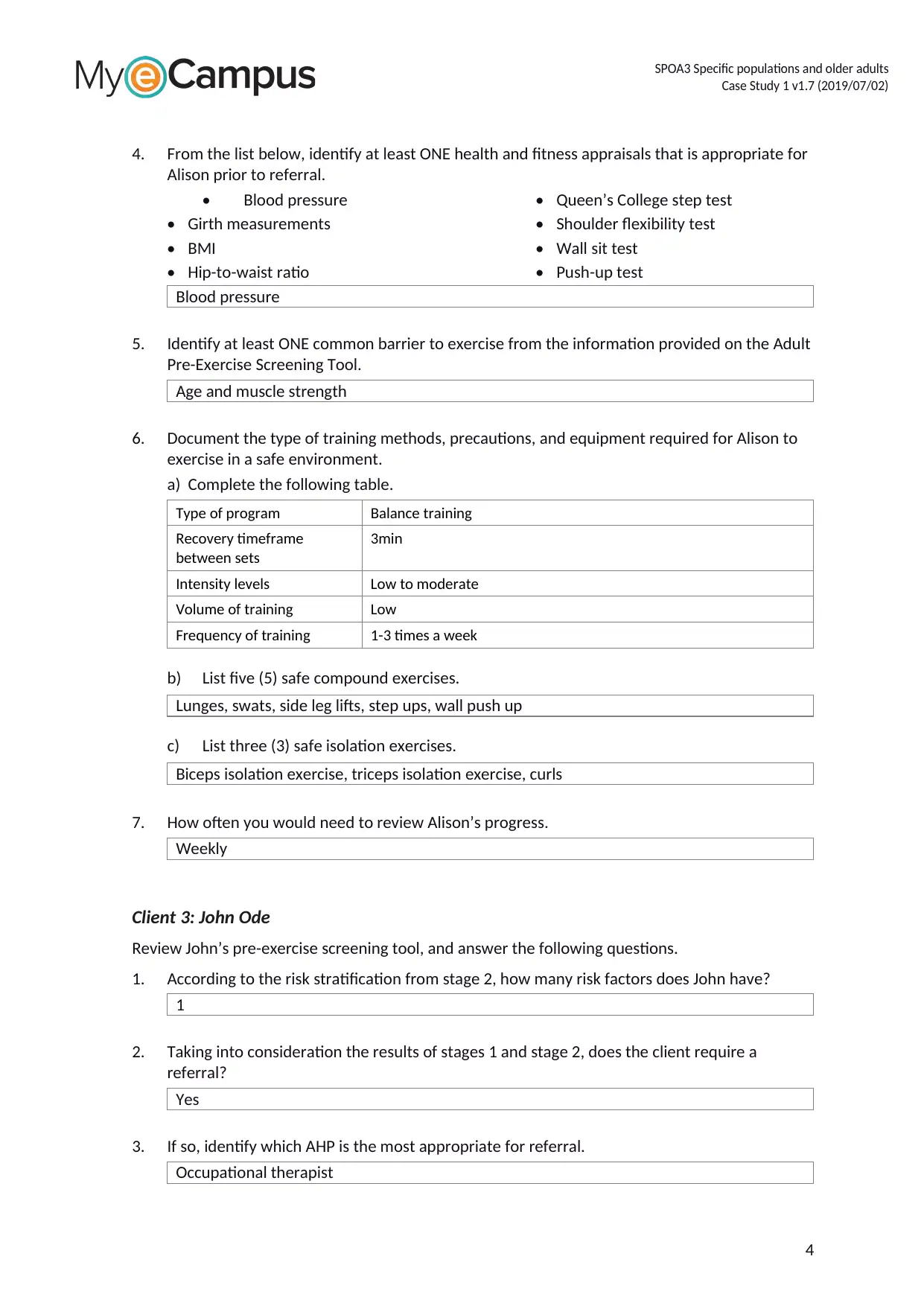
SPOA3 Specific populations and older adults
Case Study 1 v1.7 (2019/07/02)
4. From the list below, identify at least ONE health and fitness appraisals that is appropriate for
Alison prior to referral.
• Blood pressure
• Girth measurements
• BMI
• Hip-to-waist ratio
• Queen’s College step test
• Shoulder flexibility test
• Wall sit test
• Push-up test
Blood pressure
5. Identify at least ONE common barrier to exercise from the information provided on the Adult
Pre-Exercise Screening Tool.
Age and muscle strength
6. Document the type of training methods, precautions, and equipment required for Alison to
exercise in a safe environment.
a) Complete the following table.
Type of program Balance training
Recovery timeframe
between sets
3min
Intensity levels Low to moderate
Volume of training Low
Frequency of training 1-3 times a week
b) List five (5) safe compound exercises.
Lunges, swats, side leg lifts, step ups, wall push up
c) List three (3) safe isolation exercises.
Biceps isolation exercise, triceps isolation exercise, curls
7. How often you would need to review Alison’s progress.
Weekly
Client 3: John Ode
Review John’s pre-exercise screening tool, and answer the following questions.
1. According to the risk stratification from stage 2, how many risk factors does John have?
1
2. Taking into consideration the results of stages 1 and stage 2, does the client require a
referral?
Yes
3. If so, identify which AHP is the most appropriate for referral.
Occupational therapist
4
Case Study 1 v1.7 (2019/07/02)
4. From the list below, identify at least ONE health and fitness appraisals that is appropriate for
Alison prior to referral.
• Blood pressure
• Girth measurements
• BMI
• Hip-to-waist ratio
• Queen’s College step test
• Shoulder flexibility test
• Wall sit test
• Push-up test
Blood pressure
5. Identify at least ONE common barrier to exercise from the information provided on the Adult
Pre-Exercise Screening Tool.
Age and muscle strength
6. Document the type of training methods, precautions, and equipment required for Alison to
exercise in a safe environment.
a) Complete the following table.
Type of program Balance training
Recovery timeframe
between sets
3min
Intensity levels Low to moderate
Volume of training Low
Frequency of training 1-3 times a week
b) List five (5) safe compound exercises.
Lunges, swats, side leg lifts, step ups, wall push up
c) List three (3) safe isolation exercises.
Biceps isolation exercise, triceps isolation exercise, curls
7. How often you would need to review Alison’s progress.
Weekly
Client 3: John Ode
Review John’s pre-exercise screening tool, and answer the following questions.
1. According to the risk stratification from stage 2, how many risk factors does John have?
1
2. Taking into consideration the results of stages 1 and stage 2, does the client require a
referral?
Yes
3. If so, identify which AHP is the most appropriate for referral.
Occupational therapist
4
Paraphrase This Document
Need a fresh take? Get an instant paraphrase of this document with our AI Paraphraser
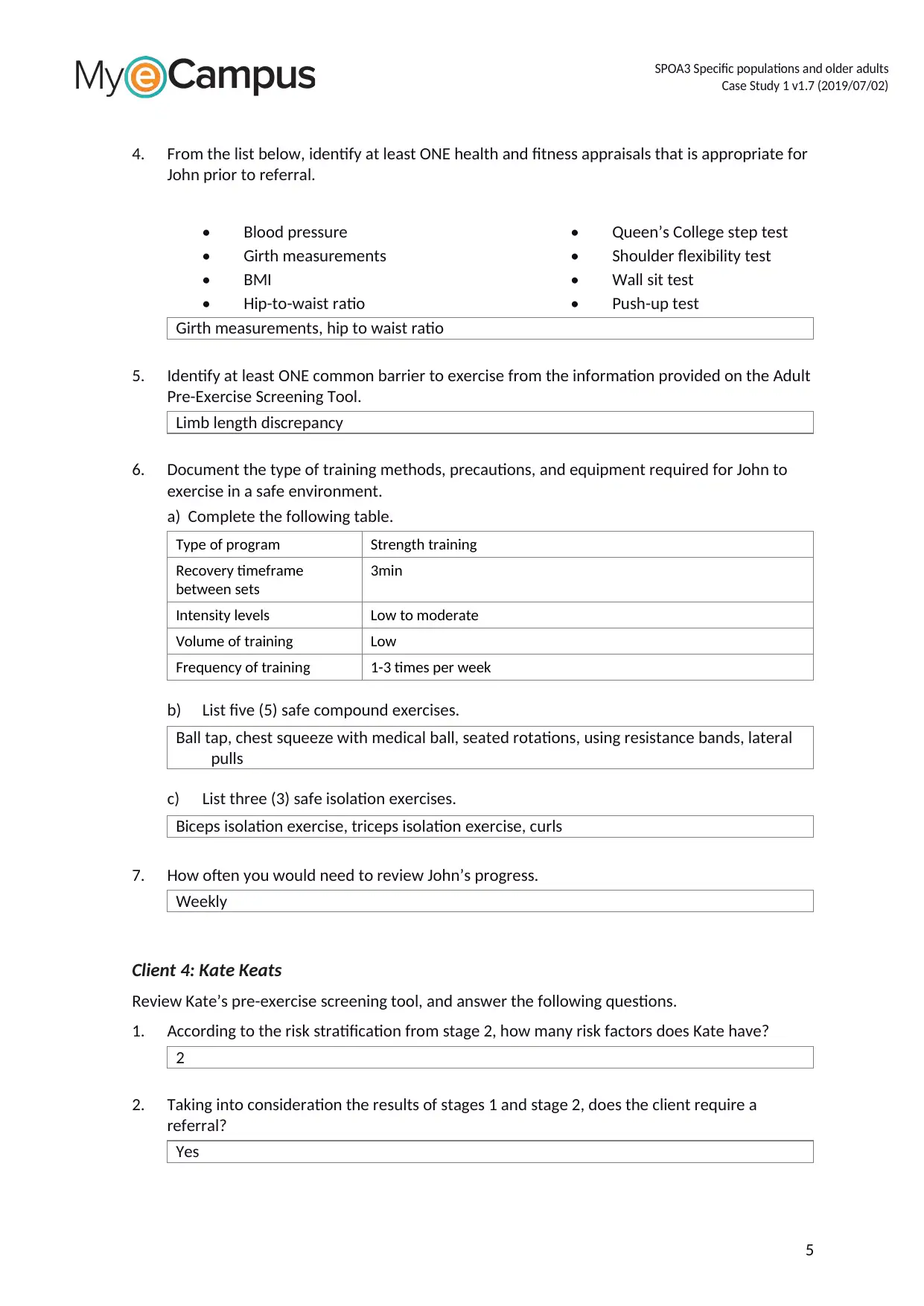
SPOA3 Specific populations and older adults
Case Study 1 v1.7 (2019/07/02)
4. From the list below, identify at least ONE health and fitness appraisals that is appropriate for
John prior to referral.
• Blood pressure
• Girth measurements
• BMI
• Hip-to-waist ratio
• Queen’s College step test
• Shoulder flexibility test
• Wall sit test
• Push-up test
Girth measurements, hip to waist ratio
5. Identify at least ONE common barrier to exercise from the information provided on the Adult
Pre-Exercise Screening Tool.
Limb length discrepancy
6. Document the type of training methods, precautions, and equipment required for John to
exercise in a safe environment.
a) Complete the following table.
Type of program Strength training
Recovery timeframe
between sets
3min
Intensity levels Low to moderate
Volume of training Low
Frequency of training 1-3 times per week
b) List five (5) safe compound exercises.
Ball tap, chest squeeze with medical ball, seated rotations, using resistance bands, lateral
pulls
c) List three (3) safe isolation exercises.
Biceps isolation exercise, triceps isolation exercise, curls
7. How often you would need to review John’s progress.
Weekly
Client 4: Kate Keats
Review Kate’s pre-exercise screening tool, and answer the following questions.
1. According to the risk stratification from stage 2, how many risk factors does Kate have?
2
2. Taking into consideration the results of stages 1 and stage 2, does the client require a
referral?
Yes
5
Case Study 1 v1.7 (2019/07/02)
4. From the list below, identify at least ONE health and fitness appraisals that is appropriate for
John prior to referral.
• Blood pressure
• Girth measurements
• BMI
• Hip-to-waist ratio
• Queen’s College step test
• Shoulder flexibility test
• Wall sit test
• Push-up test
Girth measurements, hip to waist ratio
5. Identify at least ONE common barrier to exercise from the information provided on the Adult
Pre-Exercise Screening Tool.
Limb length discrepancy
6. Document the type of training methods, precautions, and equipment required for John to
exercise in a safe environment.
a) Complete the following table.
Type of program Strength training
Recovery timeframe
between sets
3min
Intensity levels Low to moderate
Volume of training Low
Frequency of training 1-3 times per week
b) List five (5) safe compound exercises.
Ball tap, chest squeeze with medical ball, seated rotations, using resistance bands, lateral
pulls
c) List three (3) safe isolation exercises.
Biceps isolation exercise, triceps isolation exercise, curls
7. How often you would need to review John’s progress.
Weekly
Client 4: Kate Keats
Review Kate’s pre-exercise screening tool, and answer the following questions.
1. According to the risk stratification from stage 2, how many risk factors does Kate have?
2
2. Taking into consideration the results of stages 1 and stage 2, does the client require a
referral?
Yes
5
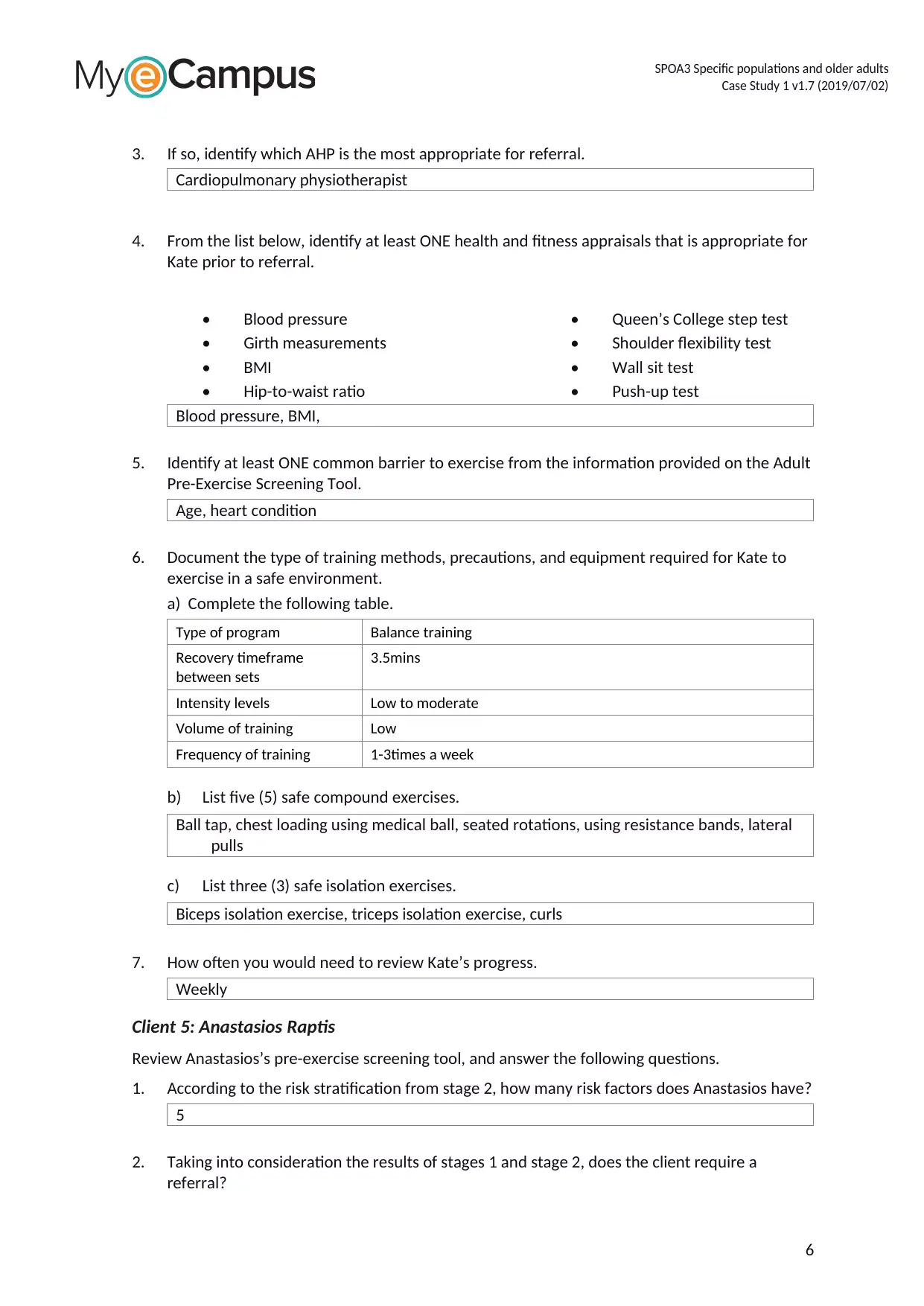
SPOA3 Specific populations and older adults
Case Study 1 v1.7 (2019/07/02)
3. If so, identify which AHP is the most appropriate for referral.
Cardiopulmonary physiotherapist
4. From the list below, identify at least ONE health and fitness appraisals that is appropriate for
Kate prior to referral.
• Blood pressure
• Girth measurements
• BMI
• Hip-to-waist ratio
• Queen’s College step test
• Shoulder flexibility test
• Wall sit test
• Push-up test
Blood pressure, BMI,
5. Identify at least ONE common barrier to exercise from the information provided on the Adult
Pre-Exercise Screening Tool.
Age, heart condition
6. Document the type of training methods, precautions, and equipment required for Kate to
exercise in a safe environment.
a) Complete the following table.
Type of program Balance training
Recovery timeframe
between sets
3.5mins
Intensity levels Low to moderate
Volume of training Low
Frequency of training 1-3times a week
b) List five (5) safe compound exercises.
Ball tap, chest loading using medical ball, seated rotations, using resistance bands, lateral
pulls
c) List three (3) safe isolation exercises.
Biceps isolation exercise, triceps isolation exercise, curls
7. How often you would need to review Kate’s progress.
Weekly
Client 5: Anastasios Raptis
Review Anastasios’s pre-exercise screening tool, and answer the following questions.
1. According to the risk stratification from stage 2, how many risk factors does Anastasios have?
5
2. Taking into consideration the results of stages 1 and stage 2, does the client require a
referral?
6
Case Study 1 v1.7 (2019/07/02)
3. If so, identify which AHP is the most appropriate for referral.
Cardiopulmonary physiotherapist
4. From the list below, identify at least ONE health and fitness appraisals that is appropriate for
Kate prior to referral.
• Blood pressure
• Girth measurements
• BMI
• Hip-to-waist ratio
• Queen’s College step test
• Shoulder flexibility test
• Wall sit test
• Push-up test
Blood pressure, BMI,
5. Identify at least ONE common barrier to exercise from the information provided on the Adult
Pre-Exercise Screening Tool.
Age, heart condition
6. Document the type of training methods, precautions, and equipment required for Kate to
exercise in a safe environment.
a) Complete the following table.
Type of program Balance training
Recovery timeframe
between sets
3.5mins
Intensity levels Low to moderate
Volume of training Low
Frequency of training 1-3times a week
b) List five (5) safe compound exercises.
Ball tap, chest loading using medical ball, seated rotations, using resistance bands, lateral
pulls
c) List three (3) safe isolation exercises.
Biceps isolation exercise, triceps isolation exercise, curls
7. How often you would need to review Kate’s progress.
Weekly
Client 5: Anastasios Raptis
Review Anastasios’s pre-exercise screening tool, and answer the following questions.
1. According to the risk stratification from stage 2, how many risk factors does Anastasios have?
5
2. Taking into consideration the results of stages 1 and stage 2, does the client require a
referral?
6
⊘ This is a preview!⊘
Do you want full access?
Subscribe today to unlock all pages.

Trusted by 1+ million students worldwide
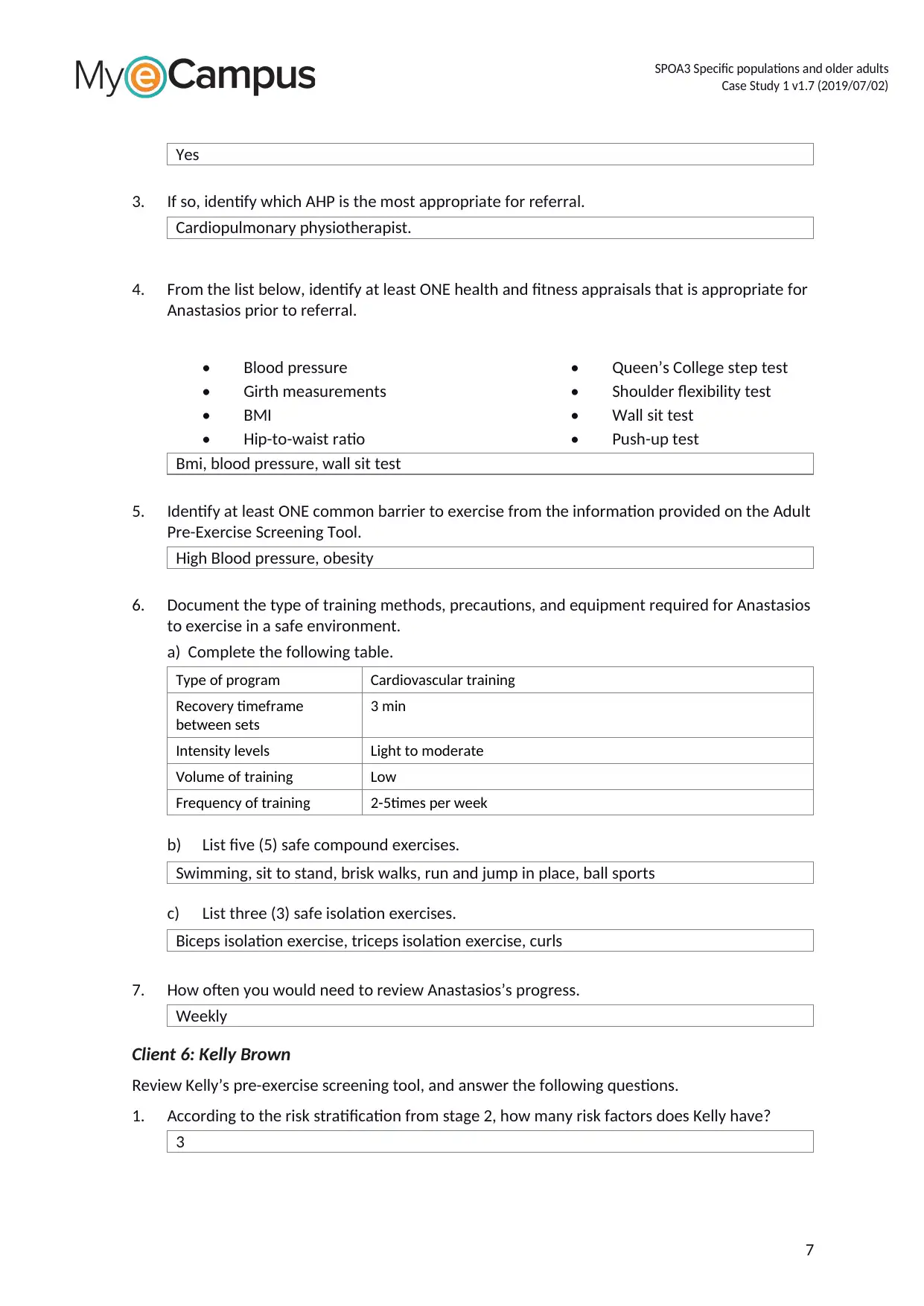
SPOA3 Specific populations and older adults
Case Study 1 v1.7 (2019/07/02)
Yes
3. If so, identify which AHP is the most appropriate for referral.
Cardiopulmonary physiotherapist.
4. From the list below, identify at least ONE health and fitness appraisals that is appropriate for
Anastasios prior to referral.
• Blood pressure
• Girth measurements
• BMI
• Hip-to-waist ratio
• Queen’s College step test
• Shoulder flexibility test
• Wall sit test
• Push-up test
Bmi, blood pressure, wall sit test
5. Identify at least ONE common barrier to exercise from the information provided on the Adult
Pre-Exercise Screening Tool.
High Blood pressure, obesity
6. Document the type of training methods, precautions, and equipment required for Anastasios
to exercise in a safe environment.
a) Complete the following table.
Type of program Cardiovascular training
Recovery timeframe
between sets
3 min
Intensity levels Light to moderate
Volume of training Low
Frequency of training 2-5times per week
b) List five (5) safe compound exercises.
Swimming, sit to stand, brisk walks, run and jump in place, ball sports
c) List three (3) safe isolation exercises.
Biceps isolation exercise, triceps isolation exercise, curls
7. How often you would need to review Anastasios’s progress.
Weekly
Client 6: Kelly Brown
Review Kelly’s pre-exercise screening tool, and answer the following questions.
1. According to the risk stratification from stage 2, how many risk factors does Kelly have?
3
7
Case Study 1 v1.7 (2019/07/02)
Yes
3. If so, identify which AHP is the most appropriate for referral.
Cardiopulmonary physiotherapist.
4. From the list below, identify at least ONE health and fitness appraisals that is appropriate for
Anastasios prior to referral.
• Blood pressure
• Girth measurements
• BMI
• Hip-to-waist ratio
• Queen’s College step test
• Shoulder flexibility test
• Wall sit test
• Push-up test
Bmi, blood pressure, wall sit test
5. Identify at least ONE common barrier to exercise from the information provided on the Adult
Pre-Exercise Screening Tool.
High Blood pressure, obesity
6. Document the type of training methods, precautions, and equipment required for Anastasios
to exercise in a safe environment.
a) Complete the following table.
Type of program Cardiovascular training
Recovery timeframe
between sets
3 min
Intensity levels Light to moderate
Volume of training Low
Frequency of training 2-5times per week
b) List five (5) safe compound exercises.
Swimming, sit to stand, brisk walks, run and jump in place, ball sports
c) List three (3) safe isolation exercises.
Biceps isolation exercise, triceps isolation exercise, curls
7. How often you would need to review Anastasios’s progress.
Weekly
Client 6: Kelly Brown
Review Kelly’s pre-exercise screening tool, and answer the following questions.
1. According to the risk stratification from stage 2, how many risk factors does Kelly have?
3
7
Paraphrase This Document
Need a fresh take? Get an instant paraphrase of this document with our AI Paraphraser
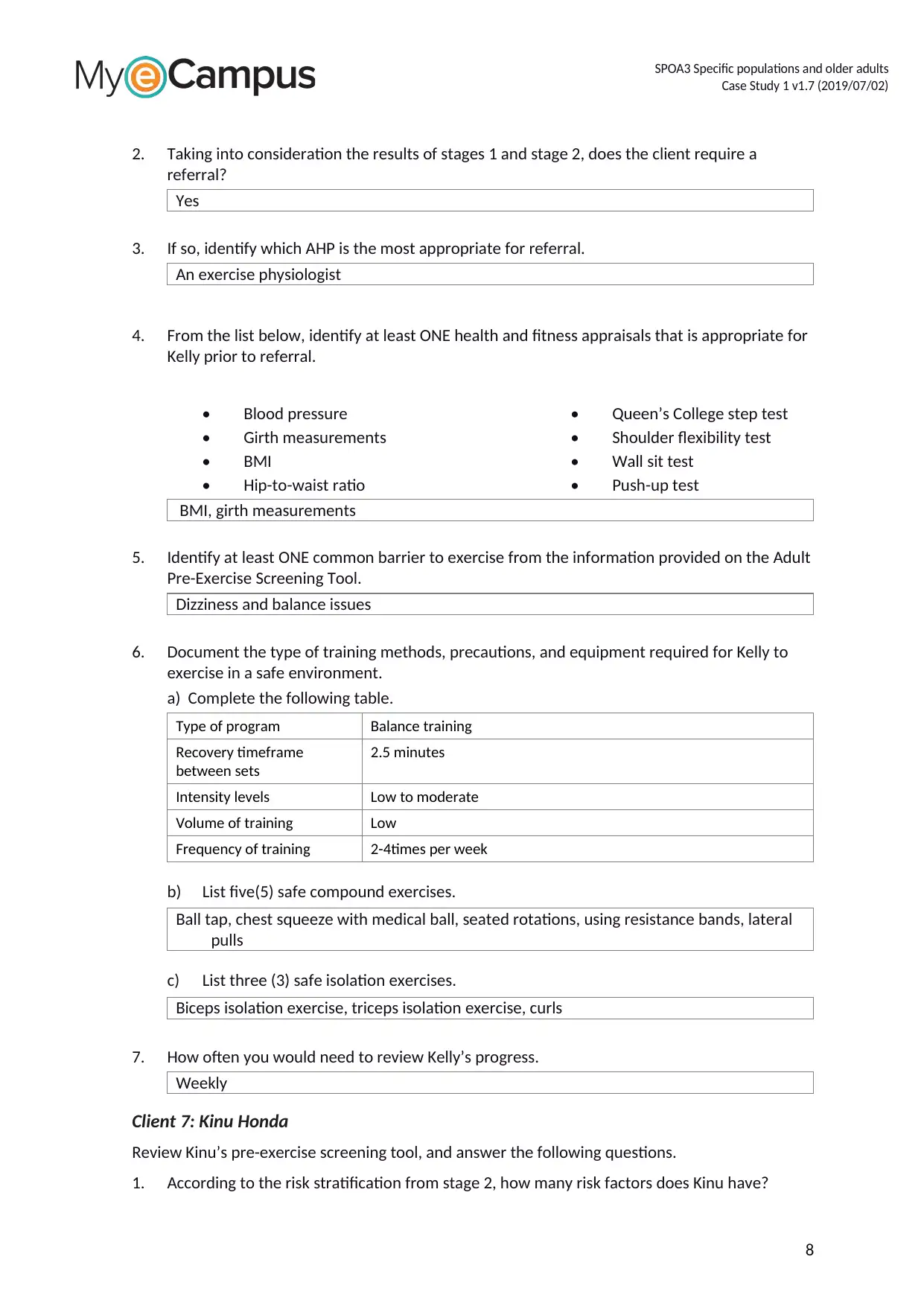
SPOA3 Specific populations and older adults
Case Study 1 v1.7 (2019/07/02)
2. Taking into consideration the results of stages 1 and stage 2, does the client require a
referral?
Yes
3. If so, identify which AHP is the most appropriate for referral.
An exercise physiologist
4. From the list below, identify at least ONE health and fitness appraisals that is appropriate for
Kelly prior to referral.
• Blood pressure
• Girth measurements
• BMI
• Hip-to-waist ratio
• Queen’s College step test
• Shoulder flexibility test
• Wall sit test
• Push-up test
BMI, girth measurements
5. Identify at least ONE common barrier to exercise from the information provided on the Adult
Pre-Exercise Screening Tool.
Dizziness and balance issues
6. Document the type of training methods, precautions, and equipment required for Kelly to
exercise in a safe environment.
a) Complete the following table.
Type of program Balance training
Recovery timeframe
between sets
2.5 minutes
Intensity levels Low to moderate
Volume of training Low
Frequency of training 2-4times per week
b) List five(5) safe compound exercises.
Ball tap, chest squeeze with medical ball, seated rotations, using resistance bands, lateral
pulls
c) List three (3) safe isolation exercises.
Biceps isolation exercise, triceps isolation exercise, curls
7. How often you would need to review Kelly’s progress.
Weekly
Client 7: Kinu Honda
Review Kinu’s pre-exercise screening tool, and answer the following questions.
1. According to the risk stratification from stage 2, how many risk factors does Kinu have?
8
Case Study 1 v1.7 (2019/07/02)
2. Taking into consideration the results of stages 1 and stage 2, does the client require a
referral?
Yes
3. If so, identify which AHP is the most appropriate for referral.
An exercise physiologist
4. From the list below, identify at least ONE health and fitness appraisals that is appropriate for
Kelly prior to referral.
• Blood pressure
• Girth measurements
• BMI
• Hip-to-waist ratio
• Queen’s College step test
• Shoulder flexibility test
• Wall sit test
• Push-up test
BMI, girth measurements
5. Identify at least ONE common barrier to exercise from the information provided on the Adult
Pre-Exercise Screening Tool.
Dizziness and balance issues
6. Document the type of training methods, precautions, and equipment required for Kelly to
exercise in a safe environment.
a) Complete the following table.
Type of program Balance training
Recovery timeframe
between sets
2.5 minutes
Intensity levels Low to moderate
Volume of training Low
Frequency of training 2-4times per week
b) List five(5) safe compound exercises.
Ball tap, chest squeeze with medical ball, seated rotations, using resistance bands, lateral
pulls
c) List three (3) safe isolation exercises.
Biceps isolation exercise, triceps isolation exercise, curls
7. How often you would need to review Kelly’s progress.
Weekly
Client 7: Kinu Honda
Review Kinu’s pre-exercise screening tool, and answer the following questions.
1. According to the risk stratification from stage 2, how many risk factors does Kinu have?
8
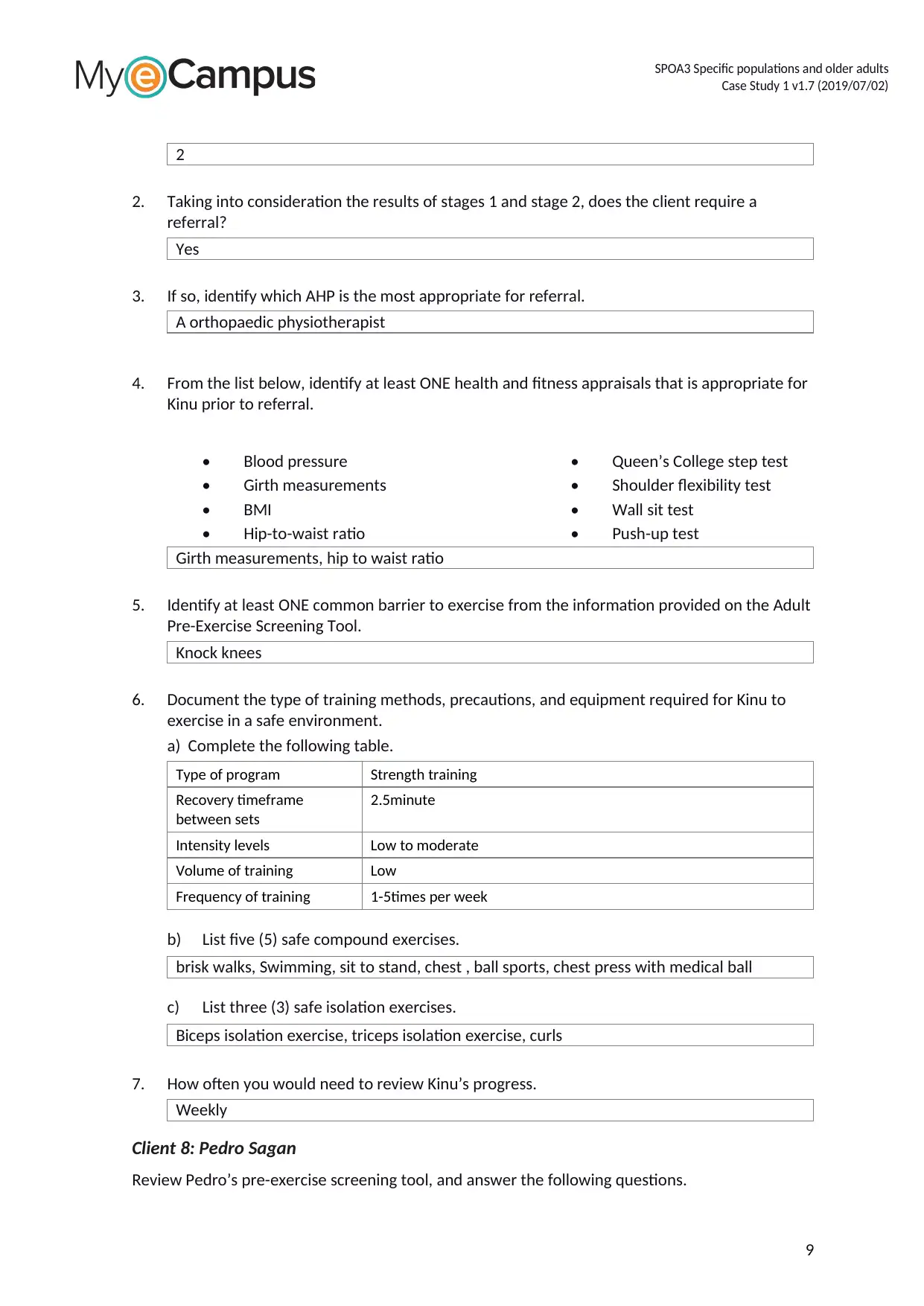
SPOA3 Specific populations and older adults
Case Study 1 v1.7 (2019/07/02)
2
2. Taking into consideration the results of stages 1 and stage 2, does the client require a
referral?
Yes
3. If so, identify which AHP is the most appropriate for referral.
A orthopaedic physiotherapist
4. From the list below, identify at least ONE health and fitness appraisals that is appropriate for
Kinu prior to referral.
• Blood pressure
• Girth measurements
• BMI
• Hip-to-waist ratio
• Queen’s College step test
• Shoulder flexibility test
• Wall sit test
• Push-up test
Girth measurements, hip to waist ratio
5. Identify at least ONE common barrier to exercise from the information provided on the Adult
Pre-Exercise Screening Tool.
Knock knees
6. Document the type of training methods, precautions, and equipment required for Kinu to
exercise in a safe environment.
a) Complete the following table.
Type of program Strength training
Recovery timeframe
between sets
2.5minute
Intensity levels Low to moderate
Volume of training Low
Frequency of training 1-5times per week
b) List five (5) safe compound exercises.
brisk walks, Swimming, sit to stand, chest , ball sports, chest press with medical ball
c) List three (3) safe isolation exercises.
Biceps isolation exercise, triceps isolation exercise, curls
7. How often you would need to review Kinu’s progress.
Weekly
Client 8: Pedro Sagan
Review Pedro’s pre-exercise screening tool, and answer the following questions.
9
Case Study 1 v1.7 (2019/07/02)
2
2. Taking into consideration the results of stages 1 and stage 2, does the client require a
referral?
Yes
3. If so, identify which AHP is the most appropriate for referral.
A orthopaedic physiotherapist
4. From the list below, identify at least ONE health and fitness appraisals that is appropriate for
Kinu prior to referral.
• Blood pressure
• Girth measurements
• BMI
• Hip-to-waist ratio
• Queen’s College step test
• Shoulder flexibility test
• Wall sit test
• Push-up test
Girth measurements, hip to waist ratio
5. Identify at least ONE common barrier to exercise from the information provided on the Adult
Pre-Exercise Screening Tool.
Knock knees
6. Document the type of training methods, precautions, and equipment required for Kinu to
exercise in a safe environment.
a) Complete the following table.
Type of program Strength training
Recovery timeframe
between sets
2.5minute
Intensity levels Low to moderate
Volume of training Low
Frequency of training 1-5times per week
b) List five (5) safe compound exercises.
brisk walks, Swimming, sit to stand, chest , ball sports, chest press with medical ball
c) List three (3) safe isolation exercises.
Biceps isolation exercise, triceps isolation exercise, curls
7. How often you would need to review Kinu’s progress.
Weekly
Client 8: Pedro Sagan
Review Pedro’s pre-exercise screening tool, and answer the following questions.
9
⊘ This is a preview!⊘
Do you want full access?
Subscribe today to unlock all pages.

Trusted by 1+ million students worldwide

SPOA3 Specific populations and older adults
Case Study 1 v1.7 (2019/07/02)
1. According to the risk stratification from stage 2, how many risk factors does Pedro have?
5
2. Taking into consideration the results of stages 1 and stage 2, does the client require a
referral?
Yes
3. If so, identify which AHP is the most appropriate for referral.
cardiorespiratory physiotherapist
4. From the list below, identify at least ONE health and fitness appraisals that is appropriate for
Pedro prior to referral.
• Blood pressure
• Girth measurements
• BMI
• Hip-to-waist ratio
• Queen’s College step test
• Shoulder flexibility test
• Wall sit test
• Push-up test
Blood pressure, hip to waist ratio, wall sit test
5. Identify at least ONE common barrier to exercise from the information provided on the Adult
Pre-Exercise Screening Tool.
Chest pain
6. Document the type of training methods, precautions, and equipment required for Pedro to
exercise in a safe environment.
a) Complete the following table.
Type of program Cardiovascular training
Recovery timeframe
between sets
3 minutes
Intensity levels Light to moderate
Volume of training Low
Frequency of training 3-7times per week
b) List five (5) safe compound exercises.
Swimming, sit to stand, brisk walks, run and jump in place, ball sports
c) List three (3) safe isolation exercises.
Biceps isolation exercise, triceps isolation exercise, curls
7. How often you would need to review Pedro’s progress.
Weekly
Client 9: Ann Marie
Review Ann’s pre-exercise screening tool, and answer the following questions.
10
Case Study 1 v1.7 (2019/07/02)
1. According to the risk stratification from stage 2, how many risk factors does Pedro have?
5
2. Taking into consideration the results of stages 1 and stage 2, does the client require a
referral?
Yes
3. If so, identify which AHP is the most appropriate for referral.
cardiorespiratory physiotherapist
4. From the list below, identify at least ONE health and fitness appraisals that is appropriate for
Pedro prior to referral.
• Blood pressure
• Girth measurements
• BMI
• Hip-to-waist ratio
• Queen’s College step test
• Shoulder flexibility test
• Wall sit test
• Push-up test
Blood pressure, hip to waist ratio, wall sit test
5. Identify at least ONE common barrier to exercise from the information provided on the Adult
Pre-Exercise Screening Tool.
Chest pain
6. Document the type of training methods, precautions, and equipment required for Pedro to
exercise in a safe environment.
a) Complete the following table.
Type of program Cardiovascular training
Recovery timeframe
between sets
3 minutes
Intensity levels Light to moderate
Volume of training Low
Frequency of training 3-7times per week
b) List five (5) safe compound exercises.
Swimming, sit to stand, brisk walks, run and jump in place, ball sports
c) List three (3) safe isolation exercises.
Biceps isolation exercise, triceps isolation exercise, curls
7. How often you would need to review Pedro’s progress.
Weekly
Client 9: Ann Marie
Review Ann’s pre-exercise screening tool, and answer the following questions.
10
Paraphrase This Document
Need a fresh take? Get an instant paraphrase of this document with our AI Paraphraser

SPOA3 Specific populations and older adults
Case Study 1 v1.7 (2019/07/02)
1. According to the risk stratification from stage 2, how many risk factors does Ann have?
1
2. Taking into consideration the results of stages 1 and stage 2, does the client require a
referral?
Yes
3. If so, identify which AHP is the most appropriate for referral.
An orthopaedic physiotherapist
4. From the list below, identify at least ONE health and fitness appraisals that is appropriate for
Ann prior to referral.
• Blood pressure
• Girth measurements
• BMI
• Hip-to-waist ratio
• Queen’s College step test
• Shoulder flexibility test
• Wall sit test
• Push-up test
Hip to waist ratio, girth measurements, wall sit test
5. Identify at least ONE common barrier to exercise from the information provided on the Adult
Pre-Exercise Screening Tool.
Scoliosis
6. Document the type of training methods, precautions, and equipment required for Ann to
exercise in a safe environment.
a) Complete the following table.
Type of program Strength training
Recovery timeframe
between sets
3.5 min
Intensity levels Low to moderate
Volume of training Low
Frequency of training 1-3times per week
b) List five (5) safe compound exercises.
Lunges, swats, side leg lifts, step ups, wall push up
c) List three (3) safe isolation exercises.
Biceps isolation exercise, triceps isolation exercise, curls
7. How often you would need to review Ann’s progress.
Weekly
Client 10: Janet Tena
Review Janet’s pre-exercise screening tool, and answer the following questions.
11
Case Study 1 v1.7 (2019/07/02)
1. According to the risk stratification from stage 2, how many risk factors does Ann have?
1
2. Taking into consideration the results of stages 1 and stage 2, does the client require a
referral?
Yes
3. If so, identify which AHP is the most appropriate for referral.
An orthopaedic physiotherapist
4. From the list below, identify at least ONE health and fitness appraisals that is appropriate for
Ann prior to referral.
• Blood pressure
• Girth measurements
• BMI
• Hip-to-waist ratio
• Queen’s College step test
• Shoulder flexibility test
• Wall sit test
• Push-up test
Hip to waist ratio, girth measurements, wall sit test
5. Identify at least ONE common barrier to exercise from the information provided on the Adult
Pre-Exercise Screening Tool.
Scoliosis
6. Document the type of training methods, precautions, and equipment required for Ann to
exercise in a safe environment.
a) Complete the following table.
Type of program Strength training
Recovery timeframe
between sets
3.5 min
Intensity levels Low to moderate
Volume of training Low
Frequency of training 1-3times per week
b) List five (5) safe compound exercises.
Lunges, swats, side leg lifts, step ups, wall push up
c) List three (3) safe isolation exercises.
Biceps isolation exercise, triceps isolation exercise, curls
7. How often you would need to review Ann’s progress.
Weekly
Client 10: Janet Tena
Review Janet’s pre-exercise screening tool, and answer the following questions.
11
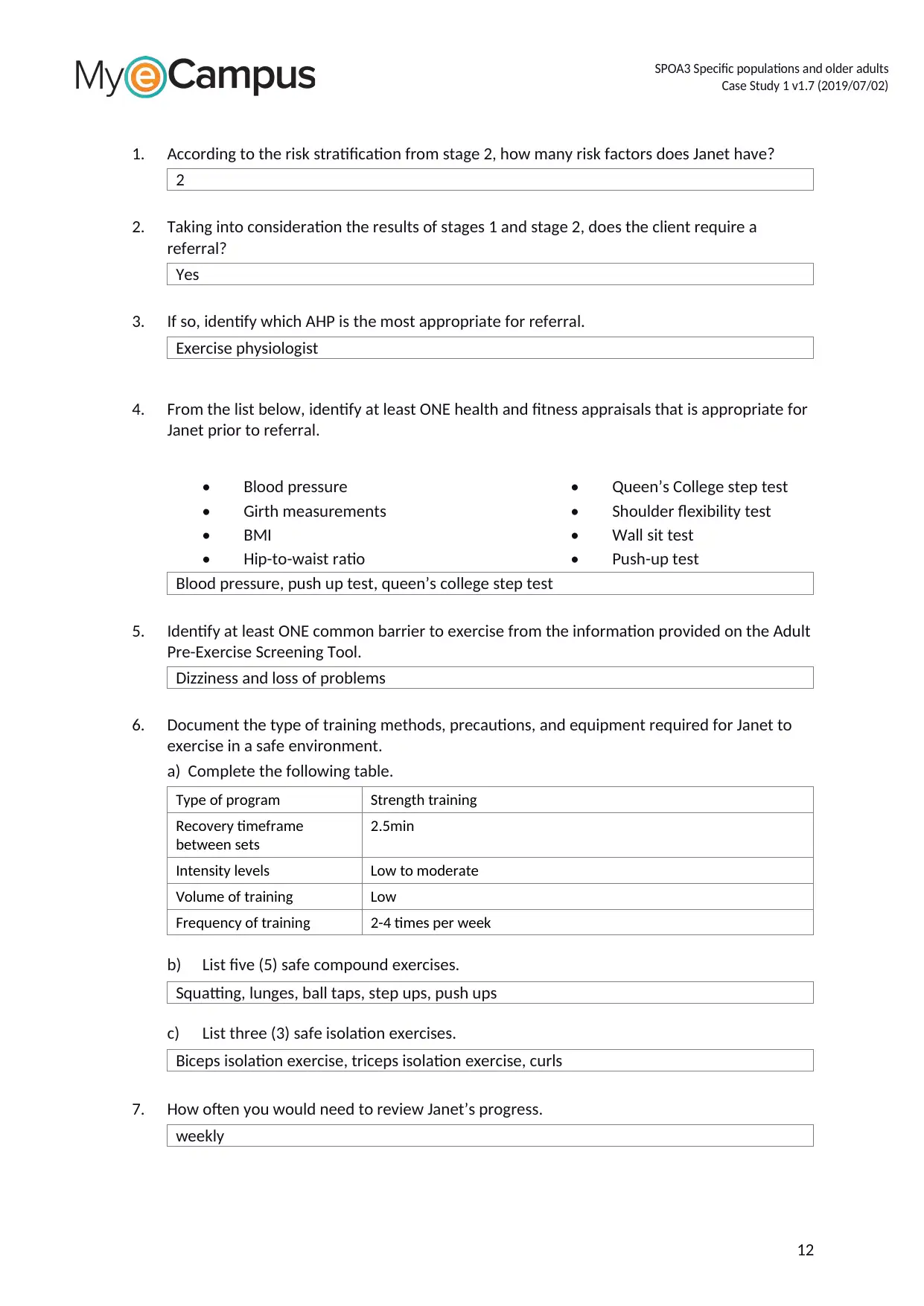
SPOA3 Specific populations and older adults
Case Study 1 v1.7 (2019/07/02)
1. According to the risk stratification from stage 2, how many risk factors does Janet have?
2
2. Taking into consideration the results of stages 1 and stage 2, does the client require a
referral?
Yes
3. If so, identify which AHP is the most appropriate for referral.
Exercise physiologist
4. From the list below, identify at least ONE health and fitness appraisals that is appropriate for
Janet prior to referral.
• Blood pressure
• Girth measurements
• BMI
• Hip-to-waist ratio
• Queen’s College step test
• Shoulder flexibility test
• Wall sit test
• Push-up test
Blood pressure, push up test, queen’s college step test
5. Identify at least ONE common barrier to exercise from the information provided on the Adult
Pre-Exercise Screening Tool.
Dizziness and loss of problems
6. Document the type of training methods, precautions, and equipment required for Janet to
exercise in a safe environment.
a) Complete the following table.
Type of program Strength training
Recovery timeframe
between sets
2.5min
Intensity levels Low to moderate
Volume of training Low
Frequency of training 2-4 times per week
b) List five (5) safe compound exercises.
Squatting, lunges, ball taps, step ups, push ups
c) List three (3) safe isolation exercises.
Biceps isolation exercise, triceps isolation exercise, curls
7. How often you would need to review Janet’s progress.
weekly
12
Case Study 1 v1.7 (2019/07/02)
1. According to the risk stratification from stage 2, how many risk factors does Janet have?
2
2. Taking into consideration the results of stages 1 and stage 2, does the client require a
referral?
Yes
3. If so, identify which AHP is the most appropriate for referral.
Exercise physiologist
4. From the list below, identify at least ONE health and fitness appraisals that is appropriate for
Janet prior to referral.
• Blood pressure
• Girth measurements
• BMI
• Hip-to-waist ratio
• Queen’s College step test
• Shoulder flexibility test
• Wall sit test
• Push-up test
Blood pressure, push up test, queen’s college step test
5. Identify at least ONE common barrier to exercise from the information provided on the Adult
Pre-Exercise Screening Tool.
Dizziness and loss of problems
6. Document the type of training methods, precautions, and equipment required for Janet to
exercise in a safe environment.
a) Complete the following table.
Type of program Strength training
Recovery timeframe
between sets
2.5min
Intensity levels Low to moderate
Volume of training Low
Frequency of training 2-4 times per week
b) List five (5) safe compound exercises.
Squatting, lunges, ball taps, step ups, push ups
c) List three (3) safe isolation exercises.
Biceps isolation exercise, triceps isolation exercise, curls
7. How often you would need to review Janet’s progress.
weekly
12
⊘ This is a preview!⊘
Do you want full access?
Subscribe today to unlock all pages.

Trusted by 1+ million students worldwide
1 out of 12
Related Documents
Your All-in-One AI-Powered Toolkit for Academic Success.
+13062052269
info@desklib.com
Available 24*7 on WhatsApp / Email
![[object Object]](/_next/static/media/star-bottom.7253800d.svg)
Unlock your academic potential
Copyright © 2020–2025 A2Z Services. All Rights Reserved. Developed and managed by ZUCOL.





